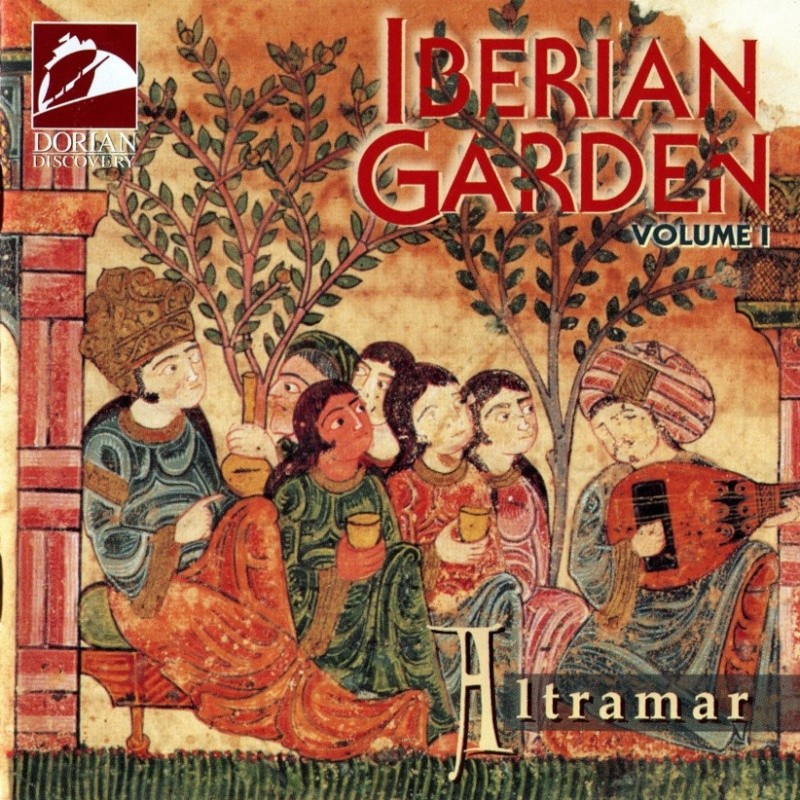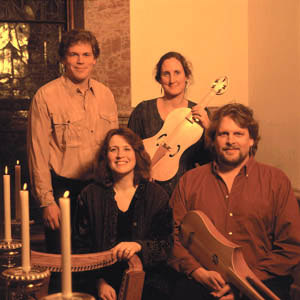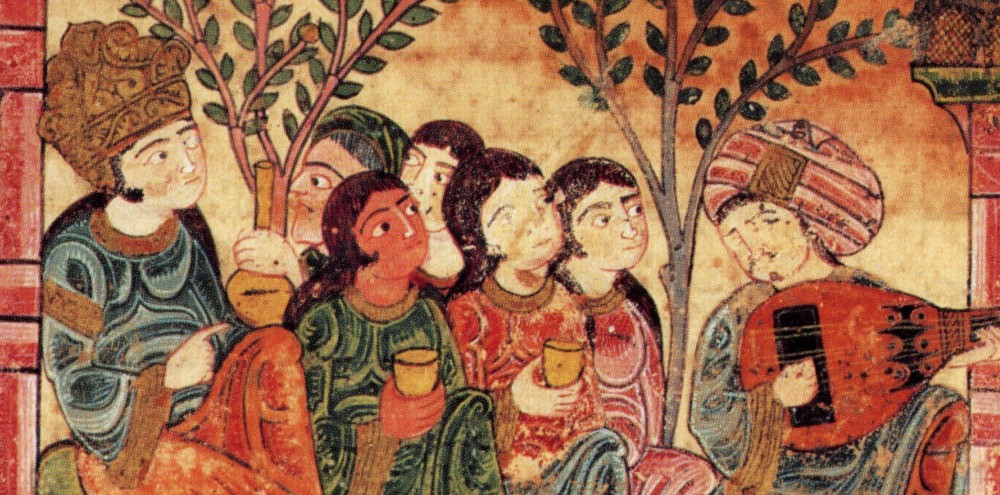Iberian Garden, vol. 1 / Altramar
Jewish, Christian, and Muslim Music in Medieval Spain

“This is a very professional and well-done CD”
medieval.org
amazon.com
altramar.org
Dorian Discovery DIS-80 151
℗1995 ©1997
1. Lababi ya‛ireni kašo’el lašaharah [0:38]
reshut · Levi Ibn al-TABBAN (fl. late 11th century)
David
2. Dum pater familias [6:05]
cc 117
cantio · Codex Calixtinus
Angela, Allison, David, Chris, Jann (vihuela d'arco)
3. Raše ‛am ‛et hitassef [14:25]
muwashshah · Yehuda ha-LEVI (1075-1141)
Angela (solo, moroccan tabla), Jann (vihuela d'arco), Chris (darabukka), David (tar)
4.Rosa das rosas [10:31]
CSM 10
Cantigas de Santa María (13th century)
David (solo), Angela (voice, harp), Chris (lute), Jann (vihuela d'arco)
5. Ma li-l-muwallah [14:14]
muwashshah · Ibn ZUHR (1113-1198)
Angela (solo, lira), Chris (oud), Jann (rebec), David (darabukka)
6. Dona si totz temps vivia [7:59]
canso · Berenguer de PALOL (fl. early 12th century)
Allison (voice, harp)
7. Eno sagrado en Vigo [4:30]
ca VI
cantiga de amigo · Martin CODAX (fl. c.1230)
David (solo, duff), Angela (harp), Chris (vihuela da mano), Jann (vihuela d'arco)
Altramar
medieval music ensemble
Jann Cosart — vihuelas d'arco, rebecs
Angela Mariani — voice, harp, lira, percussion
Chris Smith — vihuela da mano, mozarabic lute, oud, percussion
David Stattelman — voice, percussion
with
Timothy G. Johnson — shawm
Allison Zelles, voice — harp, percussion
Altramar performs on a matched set of instruments especially designed
for them by luthier Timothy G. Johnson.
Oud — unknown Persian maker.

Altramar, in the Occitan language of the troubadours, was the
name given to the Near Eastern lands that lay "over the sea", where
crusade and trade resulted in the rich cultural interchange of East and
West.
Altramar is an ensemble specializing in music of the
Medieval Era, sharing historical repertory in the context of human
experience, and evoking the vibrant tapestry of medieval culture.
Altramar combines a process of collaborative partnership with a
commitment to scholarship and expression. Since 1991, Altramar has been
presenting their unique blend of song and story, drama and rhetoric, and
voices and instruments to audiences throughout North America.
Altramar
uses instruments appropriate to the times and places of their
repertoire. Most of the information about medieval instruments comes
from iconography, because very few of the originals survive. By studying
paintings and sculptures, one can discover which instruments were
played when and where. Also, clues can be found which suggest
construction techniques of medieval craftsmen. Luthier Timothy G.
Johnson has created a matched set of instruments for Altramar using this
type of research.
Altramar can be found on the World Wide Web at: http://www.indiana.edu/~altramar and contacted via eMail at: altramar@indiana.edu
Catalog No. DIS-80151
Recorded at The Church of the Immaculate Conception, Saint Mary-of-the-Woods, Indiana in December 1994 and November 1995.
Session Producers: Timothy G. Johnson, Peter Nothnagle
Engineer & Editor. Peter Nothnagle
Post Session Production: Altramar
Mastering Engineer: David H. Walters
Booklet Preparation & Editing: Katherine A. Dory
Graphic Design: Kimberly Smith Co.
Cover Art: Vatican City, Biblioteca Apostolica Vaticana, MS. Vat. Arab, 368, fol. 10r.
Altramar
would like to thank Abdullah al-Malik, Luis Beltrán, Thomas Binkley,
Federico Corriente, Liljana Elverskog, Stephen Katz, Consuelo
Lopez-Morillas, James Monroe, Angel Saenz-Badillos, Josep Miguel Sobrer,
Byron Stayskal and the community of the Sisters of Providence, Saint
Mary-of-the-Woods, Indiana.
All transcriptions, reconstructions,
realizations, original compositions and arrangements copyright 1994 by
Altramar medieval music ensemble are protected under copyright law and
may not be used by others without express permission.
℗1995 Altramar
©1997 DORIAN DISCOVERY. A division of The Dorian Group, Ltd.
notas en español

In
the Middle Ages, the interaction of cultures in the Iberian Peninsula
created a cosmopolitan world in which people of differing ethnicities,
backgrounds and religious faiths lived, loved, battled, and learned from
one another. This was the Golden Age of Hebrew poetry, a high point of
Islamic science and art, a flowering of Christian theology and music;
all learned and shared in this Golden Age. Musicians and
mathematicians; poets, painters and politicians; architects and artists;
nobility and common people traded, studied, sang and worked together.
In 1993, the eminent scholar and performer Thomas Binkley challenged the members of Altramar
to create a program of medieval music that would, for the first time,
give equal representation to the extraordinary musical, literary and
spiritual diversity of Jewish, Christian and Muslim Spain. Such a
project, we all agreed, would require the inclusion of pieces in
Castilian, Catalan, Gallego-Portuguese, Latin, Hebrew, colloquial and
formal Arabic — and, in addition, a plethora of specific musical styles
and techniques. “If you can do that”, he said, “you really will have
done something unique”. Tom Binkley did not live to hear the final
result, but his indomitable spirit inspired and continues to inspire us.
The
attainment of our goal was a complex process. Primary sources for
poetic texts abound for all three cultures, and the existence of rich
and extensive musical activity is well-documented. But there is a
crucial gap in the evidence: while the Christian music traditions of
medieval Spain are preserved in manuscripts, and the post-medieval sung
repertoires of both Andalusian and Sephardic oral tradition are still
widely-performed, definitive sources for certifiably “medieval” Arabic
and Jewish melodies are scant or nonexistent.
Consequently, we
made a decision to use only texts known to originate in the medieval
period, and turned to firsthand medieval descriptions and to the
still-thriving oral traditions to inform our musical decisions. It is
our hope that the results, which are in one sense “new”, nevertheless
capture the sound and spirit of the old, displaying these jewels of
medieval sung-poetry in settings that aptly reflect their transcendent
beauty.
MUWASHSHAH AND ZAJAL
Some of the repertoire represented in this collection is in relatively familiar forms: hymn, cantiga, love lyric; even the piyyut
continues as a familiar part of the modern Jewish repertory. However,
some other forms, especially those from the Arabo-Andalusian tradition,
are perhaps less familiar.
The muwashshah and the zajal
developed as poetic and musical idioms in Arabic Spain during the tenth
and eleventh centuries, were subsequently borrowed by Hebrew poets, and
are still performed today in the Maghrib. Andalusian Jewish poets, many
of whom held high positions in culturally sophisticated Arabic courts,
admired and imitated the Arabic love lyric, whose lush and evocative
language they saw mirrored in the Song of Songs. Jewish poets of the
Golden Age synthesized elements of the Arabic repertoire's imagery and
conventions with their own rich poetic traditions, and the result was a
tradition that paralleled the Arabo-Andalusian one: muwashshahat in Hebrew on a variety of sacred and secular topics.
The text of the medieval Arabic muwashshah is typically in the classical language, while the second part of the last stanza, or jarcha,
is in either colloquial Arabic or a Hispanic romance dialect, and is
believed to be borrowed from popular sources. In another example of
parallel usage, the jarcha of the Hebrew muwashshah was
also often written in a Romance dialect, and thus displays an
interesting example of the interaction between vernacular and high-art
genres.
As part of the modern nawba, a suite of musical pieces grouped by mode and performed in sequence, the Arabo-Andalusian muwashshah is played by a group of instrumentalists and sung by either a chorus or a soloist alternating with choral refrains.1
The zajal,
the largest extant collection of which is by the Andalusian poet Ibn
Quzman, is a lyric, strophic form in colloquial Arabic. Interestingly,
many zajals share an aspect of musical structure with the Spanish cantiga, the Italian lauda, and the French virelai: in each, the melody of the refrain recurs as the closing section (vuelta)
of each stanza. This structure is widespread in traditional European
folk music, and appears in Arabic song only after the Muslim conquest of
Andalusia. The extent of Arabic influence on the music and poetry of
Europe is widely and hotly debated: here is one instance in which the
influence might just as easily have gone in the opposite direction.
muwashshahat and zajals
made up the bulk of the repertoire of young female singers who were
basically highly-prized slaves. These women were trained from childhood
in the memorization and performance of the sung poetic forms, and their
cultural and economic value increased according to their skill. When a
young woman was sold, her price was negotiated through examination of a
large volume that detailed the scope and nature of her repertoire. The
most highly-prized singers also brought to their employers an ensemble
of musicians, trained in the accompaniment of these pieces.
No music survives for the medieval muwashshah and zajal,
and, while medieval sources provide some descriptions of the poetry and
performance, they alone do not give enough information to reconstruct
the music. Here is a situation in which parallel musical traditions
become particularly important to the historical performer. The modern
Andalusian oral tradition, known and so identified throughout North
Africa (Tunisia, Morocco, and Algeria), retains particularly strong and
immediate roots with its medieval Iberian ancestry, a retention attested
by the self-identification of modern players with the lineages of
medieval teachers. The connection is nearly as immediate in the
repertoire itself: many examples of muwashshah and zajal
in the modern Andalusian oral tradition adhere closely to the original
medieval texts, giving us a point of departure from which musical
reconstructions may be made. In this area, we are indebted to scholars
James Monroe and Benjamin Liu, whose book Ten Hispano-Arabic Songs in the Modern Oral Tradition (Berkeley, 1989) has been an invaluable resource for these musical realizations.
In
the fabled wine-parties of tri-cultural medieval Iberia, full
performances of these genres could last many hours. Therefore, while the
texts of the poems are given here in their deserved entirety, in some
cases we have chosen to present only two or three musical stanzas of a muwashshah.
Pronunciation
of medieval Iberian texts also requires special consideration:
pronunciation has changed greatly over the centuries, and varied
according to region and dialect. We thank Liljana Elverskog, Abdallah
Malik, Consuelo Lopez-Morillas, and Angel Saenz-Badillos for their
expert coaching in the spoken subtleties of these ancient languages.
—Altramar
1
References for such performance practice can be found as far back as
the thirteenth century; see James T. Monroe and Benjamin Liu, Ten Hispano-Arabic Strophic Songs in the Modern Oral Tradition (Berkeley, 1989) p.16.

1. Reshut: Lababi ya‛ireni kašo’el lašaharah
Levi Ibn al-Tabban (fl. late 11th century)
Source: Raymond Scheindlin, The Gazelle (Philadelphia: Jewish Publication Society, 1991)
The
period from c1000-c1150CE is referred to as a Golden Age of Iberian
Jewish culture. Jewish scholars, poets, philosophers and scientists held
important official, cultural and advisory positions in both Muslim and
Christian courts.
During this Golden Age, Andalusian Jews introduced the practice of presenting poems called reshuyot,
as a preface to the standard prayers that occur between the preliminary
service and the morning service “proper”. These were, in effect, a
“beginning before the beginning”: intimate meditations sung by the
precentor, with their immediacy characterized by the consistent use of
the first person singular pronoun.
The reshuyot
typically incorporate Biblical diction, but also delight in poetical
wordplay: often the number of lines matches the number of letters in the
poet's given name; very often they incorporate an acrostic of the
poet's given name at initial of each line (as does the example presented
below).
In Arabic love lyric, the poet often spoke of the
gazelle as a metaphor for the Beloved; in Hebrew religious texts, this
was adapted to symbolize God or Israel. Ours is by Levi Ibn al-Tabban, a
grammarian and poet from Saragossa who wrote primarily liturgical
verse.
2. Cantio: Dum pater familias
Anonymous (12th century)
Source: Santiago de Compostela, Biblioteca de la Catedral (“Codex Calixtinus”)
In
the Middle Ages, Christians from Germany, France, Italy, and all over
western Europe made the pilgrimage to the Cathedral at Santiago de
Compostela, built over the grave of St James, Santiago, the patron saint
of Spain. The 12th century manuscript known as the Codex Calixtinus,
housed at the Cathedral Library, contains music associated with this
cathedral and the pilgrimage to it, and includes an observance of the
feast of St. James. Dum pater familias, a Latin cantio in
praise of the saint, comes from this collection. Its refrain
commemorates James, “first of the apostles”, martyred in Jerusalem.
3. Muwashshah: Raše ‛am ‛et hitassef
Yéhuda ha-Levi (1075-1141)
Source: Oxford, Bodleian Library, Ms. Opp. Add 4°, 81
The Hebrew muwashshah
on our program is by Yehuda ha-Levi, renowned for his contribution to
sacred and secular poetry of Andalusia's Golden Age. The poem is a
cultural melange, containing Biblical references, vernacularized Hebrew,
and elements of Arabic and Romance speech, culminating in a Romance jarcha. It is a panegyric to “Joseph”, the identity of whom has been the subject of debate.
It
has been suggested that this is a poem of messianic redemption, and
that “Joseph” is a reference to a “secondary messianic figure”, Messiah
son of Joseph, who would precede the Davidic Messiah and reunite the
tribes of Israel.1 The poem may be read on multiple levels of
meaning, as both lauding a patron and intending a symbolic, messianic
message. Our melody is informed by melodic gestures found in 13th
century Hebrew Bible cantillation symbols, formed into rhythmic song
characteristic of the Andalusian muwashshah tradition.
1 H.P. Salomon “Yehuda Halevi and hid 'Cid'” (American Sephardi IX, 1978)
4. Cantiga #10: Rosa das Rosas
Anonymous (13th century), The Cantigas de Santa María
Source: El Escorial, Real Monasterio de El Escorial, B.1.2
The
court of Alfonso X El Sabio “The Wise” (1252-1284), king of Castile and
León, was one of the cultural centers of western Europe, drawing
scholars, artists, scientists, and musicians of diverse backgrounds and
faiths. The collection of Gallego-Portuguese songs known as the Cantigas de Santa Maria, a treasury of religious folk-legend, was assembled under Alfonso's direction. These cantigas
tell of the many miracles performed by the Virgin Mary. The largest
manuscript (El Escorial B.1.2, or “E1”) is filled with illuminations
that portray Christians, Arabs, and Jews, together and separately
playing an astonishing variety of musical instruments. Every tenth cantiga in this collection departs from the narrative miracle theme and instead presents an adoring song of Marian praise; our cantiga, Rosa das Rosas, is one of these.
5. Muwashshah: Ma li-l-muwallah
Ibn Zuhr (1113-1198)
Source: Sayyid Gazi Diwan al-Muwashshat al-Andalusiyya (Alexandria: Mansha‛at al-Ma‛arif, 1979)
When
Andalusian poet Ibn Zuhr was asked which of his muwashshahat was most
excellent, he chose this one. It is a poem of yearning, full of the
sensuous imagery beloved by medieval Iberian poets of all three
cultures, and used by them to evoke both earthly and spiritual love:
sweet wine, gardens, beautiful women, the crescent moon.
Our
musical arrangement is informed by medieval Arabic prose descriptions
and by contemporary Moroccan folk music approaches. In the original
manuscript, part of the final stanza is missing; for the purpose of
performance, we repeat text from the first verse, incorporating a change
in verb tense as utilized in the modern oral tradition. On the
recording, you will hear the first and last stanzas and the jarcha. The entire text is presented below.
6. Canso: Dona si totz temps vivia
Berenguer de Palol (a.k.a. Berenguier de Palazol; fl. early 12th century)
Source: Paris, Bibliothèque Nationale, f. fr. 22543 (Troubadour ms. “R”)
The eleventh and twelfth century poet-musicians known as trobadors flourished in southern France and in neighboring Catalonia, itself a part of the Iberian culture. Much of the trobadors'
poetry, written in the language of Old Occitan, is an expression of the
“art of courtly love”, an idealized system of cultural and social
behavior between noble women and men that developed over a period of
time in Europe, with antecedents in the Middle East. The courtly lover
views himself as the servant of the beloved; love is often either
unrequited, or in some way illicit (it was common, for example, for the
lady to be married to someone else). Yet through suffering and rejection
the lover's situation becomes elevated to an almost mystical state in
which he is ennobled or illuminated by this experience of transcendent
devotion.
In the thirteenth century, the culture that had inspired the art of the trobadors was nearly destroyed by the Albigensian Crusade against the Cathar heresy; but the trobadors' influence spread far and wide, to the northern French trouvères, to the German minnesänger, to Dante and the Italian poets of the dolce stil nuovo, and beyond.
Dona, s'ieu tostems vivia is by one of the first Catalan trobadors, Berenguer de Palol, whose vida,
or biography, tells us that he was the “son of a poor knight”. Only
eight of the twelve extant songs by Berenguer have survived with their
melodies intact.
7. Cantiga de amigo: Eno sagrado en Vigo
Martim Codax (fl. c.1230)
Source: Pierpont Morgan Library, Vindel MS M979
The Gallego-Portuguese cantiga de amigo
is one of the Iberian peninsula's oldest vernacular poetic forms. The
words are most often expressed from the point of view of a woman; this
suggests that the cantigas de amigo may derive from a very old tradition of vernacular women's song.
Many of the cantigas'
recurring themes — yearning for a distant lover, confiding in a mother
or sister — are shared with women's songs from the Sephardic oral
tradition, and also with the jarchas (which were known to have
been “borrowed” from pre-existing sources). While it is impossible to
conclusively identify certain Sephardic women's songs as “medieval”,
this shared imagery suggests possible connections across genres.
Few of the melodies of the cantigas de amigo
have survived. The seven cantigas de amigo by the Gallician troubadour
Martim Codax are a notable exception: all but one are notated, and it is
that cantiga, written under an empty staff with no notes, which
we have chosen. The melody was arranged by Jann Cosan and Altramar on
the basis of the existing cantiga melodies.





